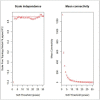Identification of hub genes associated with adult acute myeloid leukemia progression through weighted gene co-expression network analysis
- PMID: 33592582
- PMCID: PMC7950274
- DOI: 10.18632/aging.202493
Identification of hub genes associated with adult acute myeloid leukemia progression through weighted gene co-expression network analysis
Abstract
Acute myeloid leukemia (AML) is a malignancy of hematopoietic stem cells. Although many candidate genes such as CEBPA, FLT3, IDH1, and IDH2 have been associated with AML initiation and prognosis, the molecular mechanisms underlying this disease remain unclear. In this study, we used a systemic co-expression analysis method, namely weighted gene co-expression network analysis (WGCNA), to identify new candidate genes associated with adult AML progression and prognosis. We identified around 5,138 differentially expressed genes (DEGs) between AML samples (from The Cancer Genome Atlas database) and normal control samples (from the Genotype-Tissue Expression database). WGCNA identified nine co-expression modules with significant differences based on the DEGs. Among modules, the turquoise and blue ones were the most relevant to AML (P-value: turquoise 0, blue 4.64E-77). GO term and KEGG pathway analyses revealed that pathways that are commonly dysregulated in AML were all enriched in the blue and turquoise modules. A total of 15 hub genes were identified to be crucial for AML progression. PIVOT analysis revealed non-coding RNAs, transcriptional factors, and drugs associated with the hub genes. Finally, survival analysis revealed that one of the hub genes, CEACAM5, was significantly associated with AML prognosis and could serve as a potential target for AML treatment.
Keywords: AML; WGCNA; hub genes.
Conflict of interest statement
Figures






Similar articles
-
Identification of two key biomarkers CD93 and FGL2 associated with survival of acute myeloid leukaemia by weighted gene co-expression network analysis.J Cell Mol Med. 2024 Jul;28(14):e18552. doi: 10.1111/jcmm.18552. J Cell Mol Med. 2024. PMID: 39054581 Free PMC article.
-
Identifying key genes and functionally enriched pathways in acute myeloid leukemia by weighted gene co-expression network analysis.J Appl Genet. 2025 May;66(2):347-362. doi: 10.1007/s13353-024-00881-0. Epub 2024 Jul 9. J Appl Genet. 2025. PMID: 38977582
-
Identification of the key genes and microRNAs in adult acute myeloid leukemia with FLT3 mutation by bioinformatics analysis.Int J Med Sci. 2020 May 18;17(9):1269-1280. doi: 10.7150/ijms.46441. eCollection 2020. Int J Med Sci. 2020. PMID: 32547322 Free PMC article.
-
Bioinformatics Analysis Identifies Key Genes and Pathways in Acute Myeloid Leukemia Associated with DNMT3A Mutation.Biomed Res Int. 2020 Nov 23;2020:9321630. doi: 10.1155/2020/9321630. eCollection 2020. Biomed Res Int. 2020. PMID: 33299888 Free PMC article.
-
Genome-scale integrated analysis to identify prospective molecular mechanisms and therapeutic targets in isocitrate dehydrogenase 2 R140Q-mutated acute myeloid leukemia.Oncol Rep. 2019 May;41(5):2876-2888. doi: 10.3892/or.2019.7075. Epub 2019 Mar 18. Oncol Rep. 2019. PMID: 30896832 Free PMC article.
Cited by
-
Identification of two key biomarkers CD93 and FGL2 associated with survival of acute myeloid leukaemia by weighted gene co-expression network analysis.J Cell Mol Med. 2024 Jul;28(14):e18552. doi: 10.1111/jcmm.18552. J Cell Mol Med. 2024. PMID: 39054581 Free PMC article.
-
Improved biomarker discovery through a plot twist in transcriptomic data analysis.BMC Biol. 2022 Sep 24;20(1):208. doi: 10.1186/s12915-022-01398-w. BMC Biol. 2022. PMID: 36153614 Free PMC article.
-
Identification of Survival-Related Genes in Acute Myeloid Leukemia (AML) Based on Cytogenetically Normal AML Samples Using Weighted Gene Coexpression Network Analysis.Dis Markers. 2022 Sep 29;2022:5423694. doi: 10.1155/2022/5423694. eCollection 2022. Dis Markers. 2022. PMID: 36212177 Free PMC article.
-
Up-Regulation of TRIM32 Associated With the Poor Prognosis of Acute Myeloid Leukemia by Integrated Bioinformatics Analysis With External Validation.Front Oncol. 2022 Jun 8;12:848395. doi: 10.3389/fonc.2022.848395. eCollection 2022. Front Oncol. 2022. PMID: 35756612 Free PMC article.
-
Circular RNA circ_0004277 Inhibits Acute Myeloid Leukemia Progression Through MicroRNA-134-5p / Single stranded DNA binding protein 2.Bioengineered. 2022 Apr;13(4):9662-9673. doi: 10.1080/21655979.2022.2059609. Bioengineered. 2022. PMID: 35412941 Free PMC article.
References
-
- Duployez N, Marceau-Renaut A, Villenet C, Petit A, Rousseau A, Ng SW, Paquet A, Gonzales F, Barthélémy A, Leprêtre F, Pottier N, Nelken B, Michel G, et al.. The stem cell-associated gene expression signature allows risk stratification in pediatric acute myeloid leukemia. Leukemia. 2019; 33:348–57. 10.1038/s41375-018-0227-5 - DOI - PubMed
-
- Beck D, Thoms JA, Palu C, Herold T, Shah A, Olivier J, Boelen L, Huang Y, Chacon D, Brown A, Babic M, Hahn C, Perugini M, et al.. A four-gene LincRNA expression signature predicts risk in multiple cohorts of acute myeloid leukemia patients. Leukemia. 2018; 32:263–72. 10.1038/leu.2017.210 - DOI - PubMed
Publication types
MeSH terms
LinkOut - more resources
Full Text Sources
Other Literature Sources
Medical
Miscellaneous

